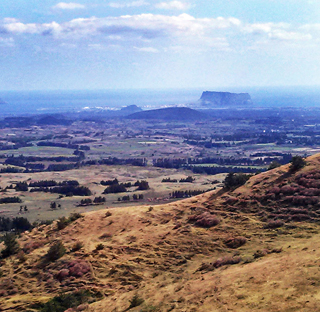FUN Geopark
December 11-17, 2021/ Jeju Island UNESCO Global Geopark,
Republic of Korea
JEJU Island
Jeju UNESCO Global Geopark - Geosites

Related Links
SECRETS OF JEJU, THE WORLD NATURAL HERITAGE SITE
For many Koreans, Jeju has long been the ideal place to spend their summer vacation or honeymoon. Tourism is the No.1 industry in the region and there are very good reasons for this. UNESCO has listed Jeju Island and its lava tubes as World Natural Heritage. Various rare creatures still inhabit the tubes and tourists can experience what time can do to nature - odd-looking stalactites and pristine water. Mt.Hallasan is the highest mountain in South Korea and was also created through volcanic activity. It is classified as dormant and thrills thousands of hikers. The eruption of Mt. Halla that took place approximately 25 thousand years ago created the Crater Lake, Baengnokdam, at the summit of the mountain. Mt. Halla rises at the center of Jeju Island, 1,950 m above sea level. The rest of the island slopes down from its summit and is covered with dark gray volcanic rocks and volcanic ash soil.
Mt.Hallasan is the highest mountain in South Korea and was also created through volcanic activity. It is classified as dormant and thrills thousands of hikers. The eruption of Mt. Halla that took place approximately 25 thousand years ago created the Crater Lake, Baengnokdam, at the summit of the mountain. Mt. Halla rises at the center of Jeju Island, 1,950 m above sea level. The rest of the island slopes down from its summit and is covered with dark gray volcanic rocks and volcanic ash soil. Seongsan Ilchulbong proves that Jeju was once an active volcanic area.
Geomun Oreum lava tubes bring fresh air to people who think Korea is over developed, as do original virgin forests from the Cenozoic Era.
WANT SOME FUN?
The whole island of Jeju is, on the other hand, a resort. There are many golf courses on the island, because the local government gave tax benefits to the owners, and more people are enjoying the mild weather and well-managed lawns. Joining hands with both European and American Professional Golf Associations to host various tournaments for promotion, the number of golf lovers visiting the island jumped by 20 percent last year, according to official data. Horseback riding, swimming, surfing, water skiing and other leisure activities are also available all over the island while a submarine allows tourists to see undersea life. Jeju is also a place to enjoy all seasonal fruits as well as some tropical ones. Pineapples, mandarin and banana farms welcome tourists to not only to buy the fruits but also to pick them. Mandarins, which were considered rare about 40 years ago, are now one of the most abundant cherished fruits there. Various products containing the fruit – from marmalade to chocolate, alcohol, perfume and others – give a mouth-watering experience to tourists at local souvenir shops and duty-free stores.
JEJU, THE ISLAND OF WORLD PEACE
Jeju is the location for peace talks in Northeast Asia and has taken the initiative to develop the Peace Practice Project by opening the Jeju Peace Forum and constructing the Jeju International Peace Center.A “FREE INTERNATIONAL CITY” LOOKING BRIGHTLY INTO THE FUTURE
Jeju Island is officially designated as a "Free International City” where the exchange of material resources and culture is given extensive freedom, and this has provided veritable wings to this island. The city boasts a cultural, social and political activity system that promotes new ideas and polices that lead practices of active peace and commits to the enjoyment of freedom protected from all elements of threat.Did you know?

- Jeju Island is 1,848.3 square-kilometers in area and has about 600,000 residents.
- Jeju marks an average 872.5 milliliters of annual rainfall, but Seogwipo City has 1,390.6 milliliters.
- Jeju is the far southern part of the Korean territory and its average temperature is 16.2 degrees Celsius, much higher than any other part of the country.
- Jeju Island is a volcanic island. Except for areas of grassland, the island comprises basalt and other igneous rocks.
- Jeju is famous for specialized farming. With abundant sunshine, water and warm weather, mandarins, pineapples as well as other tropical fruits are grown. Rape flower, shiitake mushrooms and other specialties are also grown.
- Jeju is famous for horses. When the Mongols invaded the island in the 13th century, they brought horses with them. There is a proverb: "Send your son to Seoul for studying and your horse to Jeju for training."
- Jeju is ‘abundant’ in three things: rocks, women and water.
- Jeju is ‘absent’ of three things: thieves, gates and beggars.
- Jeju has a unique dialect. It keeps the form of the old Korean language spoken more than six centuries ago.